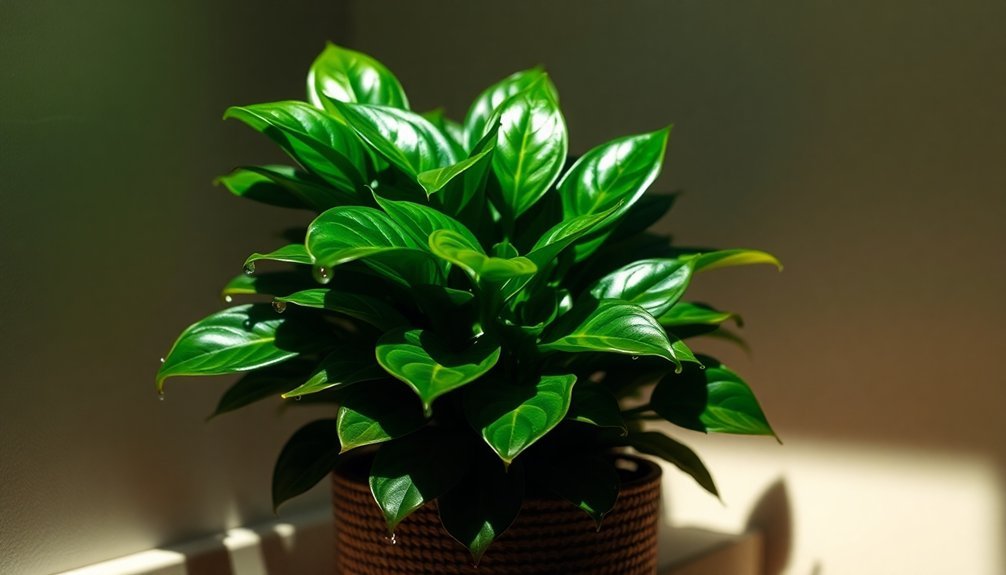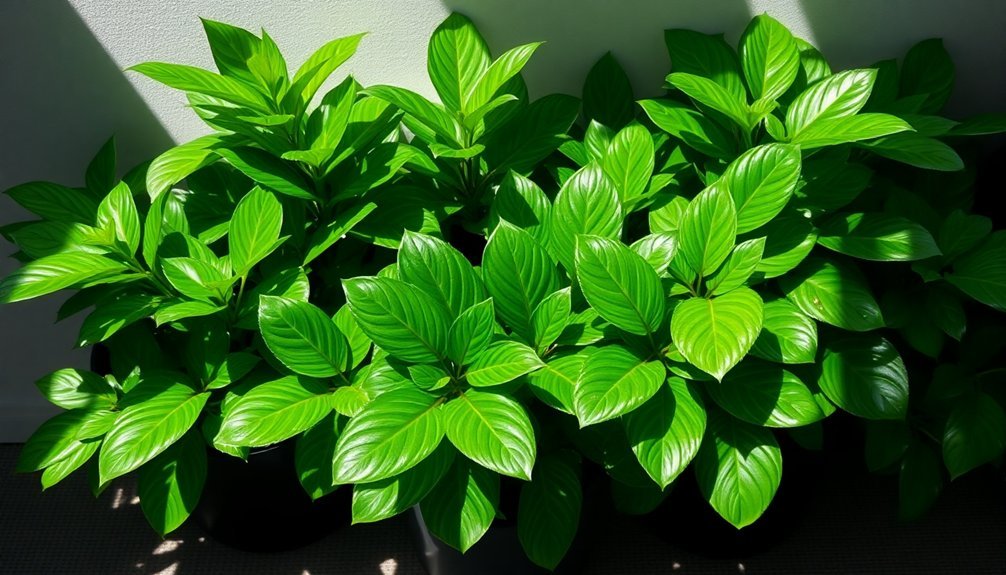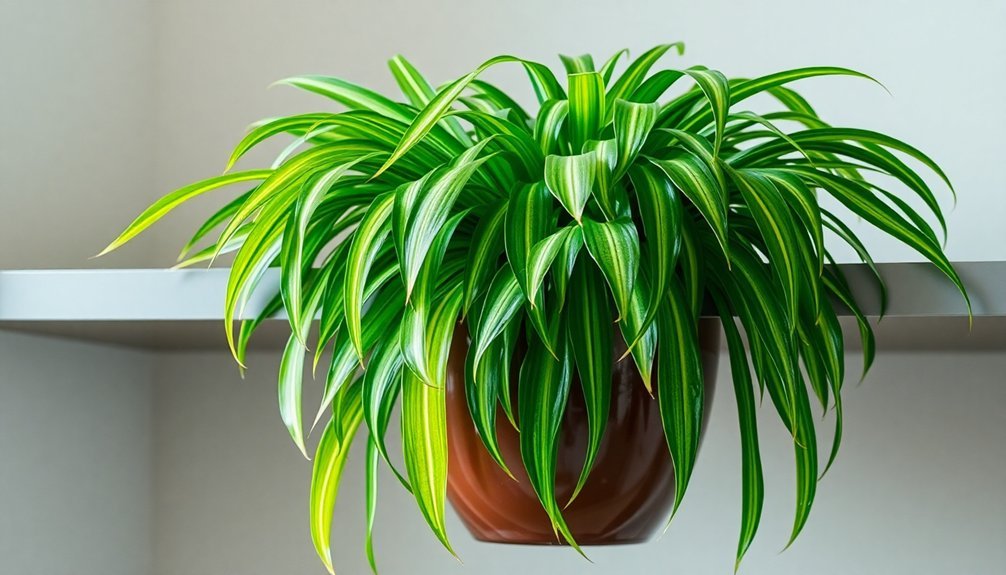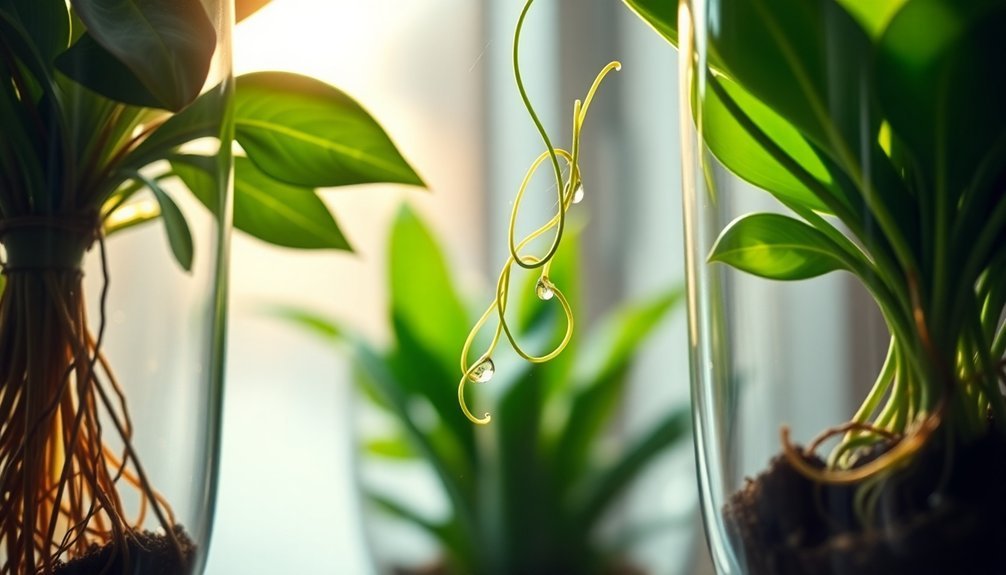Transform your windowless spaces with these nine resilient air-purifying plants: Snake Plants, Cast Iron Plants, ZZ Plants, Peace Lilies, Chinese Evergreen, Golden Pothos, Spider Plants, Dumb Cane, and Air Plants. You'll find these low-maintenance champions thrive in artificial light while removing harmful toxins like benzene and formaldehyde from your indoor air. Each plant boasts unique characteristics and care requirements that'll help you create a healthier, more vibrant indoor environment.
Why Snake Plants Are Perfect for Windowless Spaces

Ever wonder why snake plants consistently top the list of recommended houseplants for dark spaces?
These resilient plants thrive in low-light conditions while actively purifying your air. They'll remove harmful pollutants like benzene and formaldehyde, with studies showing they can eliminate up to 50% of air toxins within 24 hours.
You don't need natural light to keep these hardy plants alive. They'll adapt perfectly to artificial lighting from LED grow lights, fluorescent bulbs, or even basic desk lamps. For optimal growth, maintain a daytime temperature range of 70-90°F.
If you're worried about maintenance, don't be – snake plants are incredibly forgiving. They'll tolerate drought, dry air, and irregular watering schedules without complaint.
Plus, they rarely attract pests, making them ideal for busy people who want cleaner air without the hassle of complex plant care.
The Cast Iron Plant: Your Low-Light Champion
Just like its namesake, the cast iron plant is virtually indestructible in challenging indoor environments. You'll find it thrives in those dim corners where other plants struggle to survive, making it an excellent choice for windowless spaces. While it prefers bright, indirect light, it's remarkably adaptable to low-light conditions. This hardy plant is a smart family choice since it's completely non-toxic to children and pets.
| Feature | Benefit |
|---|---|
| Light Needs | Survives in dim corners; avoids direct sun |
| Temperature | Adapts to 60-80°F (16-27°C) |
| Watering | Drought-tolerant; needs less frequent watering |
| Air-Purifying | Filters formaldehyde, benzene, trichloroethylene |
| Maintenance | Minimal pruning; monthly fertilizing in growing season |
You won't need to fuss over humidity levels, as it adapts well to typical household conditions. Just remember to water when the top inch of soil feels dry, and you'll have a resilient air-purifier that keeps working year-round.
ZZ Plants: Thriving in Dark Corners

You'll be amazed by the ZZ plant, a drought-tolerant beauty from Africa that's earned its reputation as one of the most resilient houseplants available.
This remarkable air purifier can thrive with minimal light, making it perfect for those challenging dark corners where other plants struggle to survive.
Its ability to photosynthesize efficiently in low-light conditions, combined with its water-storing rhizomes, makes the ZZ plant your ultimate low-maintenance companion for dimly lit spaces. Growing 12 to 36 inches in containers, these adaptable plants are an excellent choice for both small and large indoor areas.
Drought-Tolerant African Beauty
A botanical marvel from East Africa, the ZZ plant (Zamioculcas zamiifolia) has earned its reputation as one of the most resilient houseplants available. You'll love how this drought-tolerant beauty adapts to various indoor conditions while purifying your air. Its thick rhizomes store water, allowing you to water only when the soil's completely dry.
| Feature | Benefit | Care Tip |
|---|---|---|
| Thick Rhizomes | Stores water for weeks | Wait for soil to dry completely |
| Glossy Leaves | Natural dust resistance | Wipe occasionally with damp cloth |
| Sturdy Stems | Minimal maintenance | Remove damaged leaves as needed |
Keep your ZZ plant away from direct sunlight and drafts, maintaining temperatures between 60-75°F. While it's incredibly forgiving, remember it's toxic if consumed, so place it away from pets and children.
Ultimate Low-Light Champion
The remarkable ZZ plant stands as nature's champion of low-light environments, making it perfect for those dim corners where other plants struggle to survive. You'll find this resilient plant thriving in conditions that would make other houseplants wither, thanks to its efficient photosynthesis process that converts minimal light into energy.
While your ZZ plant will flourish under bright, indirect light, it's equally comfortable under artificial lighting. If you're using grow lights, position them 12-18 inches above the plant and run them for 12-16 hours daily.
Just keep the temperature between 60-80°F, and remember to dust the leaves regularly to maximize light absorption. You'll want to avoid direct sunlight, as it can scorch the leaves, but don't worry about rooms with limited natural light—your ZZ plant will adapt beautifully.
Peace Lilies: Natural Air Filters for Dark Rooms
Peace lilies stand out as champions of air purification, removing harmful compounds like formaldehyde, benzene, and trichloroethylene from your indoor spaces.
You'll find these resilient plants thriving in dark rooms, as they've adapted to survive in low-light conditions while maintaining their air-filtering abilities.
With minimal care requirements and a preference for slightly damp soil, you can easily maintain these natural air filters by watching for drooping leaves as your signal to water.
Air Filtering Power Explained
Natural air filtering happens when indoor plants like peace lilies absorb and break down common pollutants through their leaves and root systems.
You'll find these plants effectively removing harmful substances like benzene from gasoline and paint, trichloroethylene from varnishes, and formaldehyde from indoor air.
While peace lilies can eliminate 23% of trichloroethylene within 24 hours, making them NASA's top-rated plant for TCE removal, they work much slower than mechanical air purifiers.
You shouldn't rely on them as your only air cleaning solution, as purifiers can remove over 99% of pollutants in under seven hours.
Instead, use peace lilies as a complementary method – they'll still help clean your air while adding humidity that can ease allergies.
The exposed soil in their pots also helps by directly absorbing airborne toxins.
Growing in Dark Spaces
While many air-purifying plants need bright conditions to thrive, peace lilies stand out as exceptional air filters for darker spaces.
These versatile plants can remove multiple VOCs, including formaldehyde, benzene, and trichloroethylene, while requiring minimal maintenance. You'll find they're perfect for rooms with little natural light, growing up to 4 feet tall indoors.
If you're looking to expand your collection of low-light air purifiers, consider these alternatives:
- Parlor Palm, which thrives in temperatures between 65-80°F
- Broad Lady Palm, capable of surviving with almost no direct sunlight
- Thatch Palm, which actually prefers shadier conditions
- Dracaena Compacta, though it's less effective at air purification than peace lilies
Keep in mind that while these plants help clean the air, they work more slowly than mechanical air purifiers.
Care and Watering Guide
Now that you've selected your low-light air purifier, maintaining its health requires specific care techniques.
Check soil moisture by inserting your finger to the first knuckle – if it's dry, water thoroughly until liquid drips from the bottom. Use lukewarm water and guarantee proper drainage to prevent root rot.
Keep your plant in bright, indirect light at temperatures between 65-80°F, away from cold drafts and direct sun.
You'll boost its health by misting every few days or placing it in naturally humid spaces like bathrooms. During spring and summer, apply liquid fertilizer every two weeks.
Don't forget regular maintenance: wipe leaves with a damp cloth, remove yellow foliage, and repot in spring if roots become crowded.
Watch for pests and treat with organic solutions when needed.
Chinese Evergreen: The Windowless Wonder

Treasured by indoor gardeners, the Chinese Evergreen stands out as one of the most versatile and efficient air-purifying plants you can grow.
You'll find this remarkable plant thriving even in the darkest corners of your home while actively removing harmful toxins like formaldehyde and benzene from your air.
What makes the Chinese Evergreen truly special is its combination of beauty and practicality.
You won't need to fuss over its care, as it's incredibly forgiving and adaptable to various indoor conditions.
- Purifies indoor air effectively while requiring minimal light
- Thrives in temperatures between 65-80°F, perfect for most homes
- Features striking leaf patterns in various shades of green, silver, and red
- Safe for homes with pets and requires watering only when the top soil is dry
Golden Pothos: Your Low-Light Air Purifier
Among the most versatile houseplants you'll ever encounter, the Golden Pothos excels at both purifying your air and adapting to challenging environments. This robust plant effectively removes harmful VOCs like formaldehyde, benzene, and toluene from your indoor space, making it an excellent choice for improving air quality.
You'll love how this low-maintenance champion thrives in various lighting conditions, even in rooms without direct sunlight. Its trailing vines and heart-shaped leaves add natural beauty to any space, whether hanging from baskets or decorating shelves.
Plus, caring for your Golden Pothos couldn't be simpler – just water when the top inch of soil feels dry and repot every few years.
Beyond its air-purifying abilities, you'll benefit from improved sleep quality, reduced stress, and enhanced overall well-being.
Spider Plants: Adaptable Air Cleaners

Spider plants rank as one of nature's most efficient air purifiers, combining powerful toxin-removing abilities with exceptional adaptability.
You'll find they excel at removing common household toxins like formaldehyde, benzene, and carbon monoxide through their leaves and roots. These hardy plants don't need much attention to thrive, making them perfect if you're new to indoor gardening.
- Captures up to 20 micrograms of particles per square centimeter of leaf surface
- Thrives in artificial light and adapts to various indoor environments
- Propagates easily through plantlets that grow on stem ends
- Increases humidity naturally while releasing oxygen
You can grow spider plants in hanging baskets or pots, and they'll flourish with moderate watering. During summer, water them liberally and mist occasionally, but reduce watering in winter.
They're particularly effective in spaces without windows, as they adapt well to low-light conditions.
Dumb Cane: A Bold Choice for Dark Spaces
While many houseplants struggle in low-light conditions, Dumb Cane stands out as a powerful air purifier that thrives in darker spaces.
You'll find this adaptable plant excels at removing harmful VOCs like formaldehyde and benzene from your air, making it perfect for rooms without natural light.
You don't need to worry about extensive maintenance – Dumb Cane only needs watering every week or two and occasional leaf cleaning to maintain its air-purifying effectiveness.
For best results, place one plant per 100 square feet of space. You'll notice it helps regulate humidity levels and absorbs noise, creating a more comfortable environment.
Beyond its practical benefits, Dumb Cane can boost your mood and productivity while reducing stress.
Its striking foliage stays attractive even in dim lighting, making it an excellent choice for your windowless spaces.
Air Plants: Soil-Free Solutions for Windowless Areas

Living in spaces without windows doesn't mean you can't enjoy the benefits of indoor plants, thanks to the remarkable adaptability of air plants. These unique epiphytes thrive under artificial full-spectrum lighting and don't need soil to flourish.
You'll find them particularly useful for improving air quality, as they absorb carbon dioxide and filter out airborne toxins like formaldehyde and benzene.
- Mount them on wood, rocks, or decorative objects to create eye-catching displays
- Use their trichomes to naturally absorb moisture and nutrients from the air
- Benefit from their stress-reducing properties and mood-boosting effects
- Enjoy their pet-friendly nature and long-term resilience
Their space-efficient design and low maintenance requirements make them perfect for small, windowless areas while still providing the health benefits of traditional houseplants.
Frequently Asked Questions
How Often Should I Rotate Indoor Plants in Windowless Spaces?
You should rotate your indoor plants in windowless spaces every 1-2 weeks, or each time you water them. Turn them a quarter rotation to guarantee even growth under your artificial lighting system.
Can Air-Purifying Plants Survive in Bathrooms With Only Artificial Light?
Yes, you can grow several air-purifying plants in your bathroom. Peace Lilies, Snake Plants, and Chinese Evergreens will thrive with artificial light and actually benefit from the bathroom's natural humidity.
Do These Plants Release Oxygen at Night Without Natural Light?
Yes, these plants will still release oxygen at night under artificial light. You'll get the best results from Snake Plants, Peace Lilies, and ZZ Plants, as they're specifically adapted to low-light photosynthesis.
What's the Best Fertilizer Schedule for Plants Growing in Windowless Conditions?
You'll need to fertilize your low-light plants monthly with a diluted balanced fertilizer (20-20-20) during growing season. Cut back to quarterly feeding in winter, using half strength to prevent nutrient buildup.
How Close Should Artificial Lights Be Positioned to These Plants?
You'll want to keep LED lights 12-24 inches away, T5 fluorescents 3-12 inches away, and HID bulbs 24-60 inches away from your plants. Monitor them for signs of heat stress and adjust accordingly.
In Summary
You don't need direct sunlight to enjoy the benefits of air-purifying plants in your home. These nine resilient species will thrive in low-light conditions while cleaning your indoor air. Whether you're looking to green up a windowless bathroom, basement, or office space, you'll find the perfect plant companion among these options. Start with one or combine several to create your own oxygen-rich indoor sanctuary.
References
- https://filti.com/best-houseplants-for-clean-air-at-home/
- https://www.co2meter.com/blogs/news/nasa-compiles-list-of-best-plants-to-clean-indoor-air
- https://plantlane.com/blogs/top-10-plants/top-10-air-purifying-plants-to-refine-the-indoor-ambiance
- https://www.makerstations.io/plants-for-windowless-home-office/
- https://gardengoodsdirect.com/collections/clean-air-plants
- https://flowerri.com/blogs/houseplant/the-ultimate-guide-to-caring-for-low-light-snake-plants
- https://easyplant.com/blog/snake-plant-purify-air
- https://www.healthline.com/health/benefits-of-snake-plant
- https://www.youtube.com/watch?v=pNQRXF36SK0
- https://www.leafenvy.co.uk/blogs/plant-care-tips/top-5-benefits-of-having-a-snake-plant-in-your-home





Leave a Reply